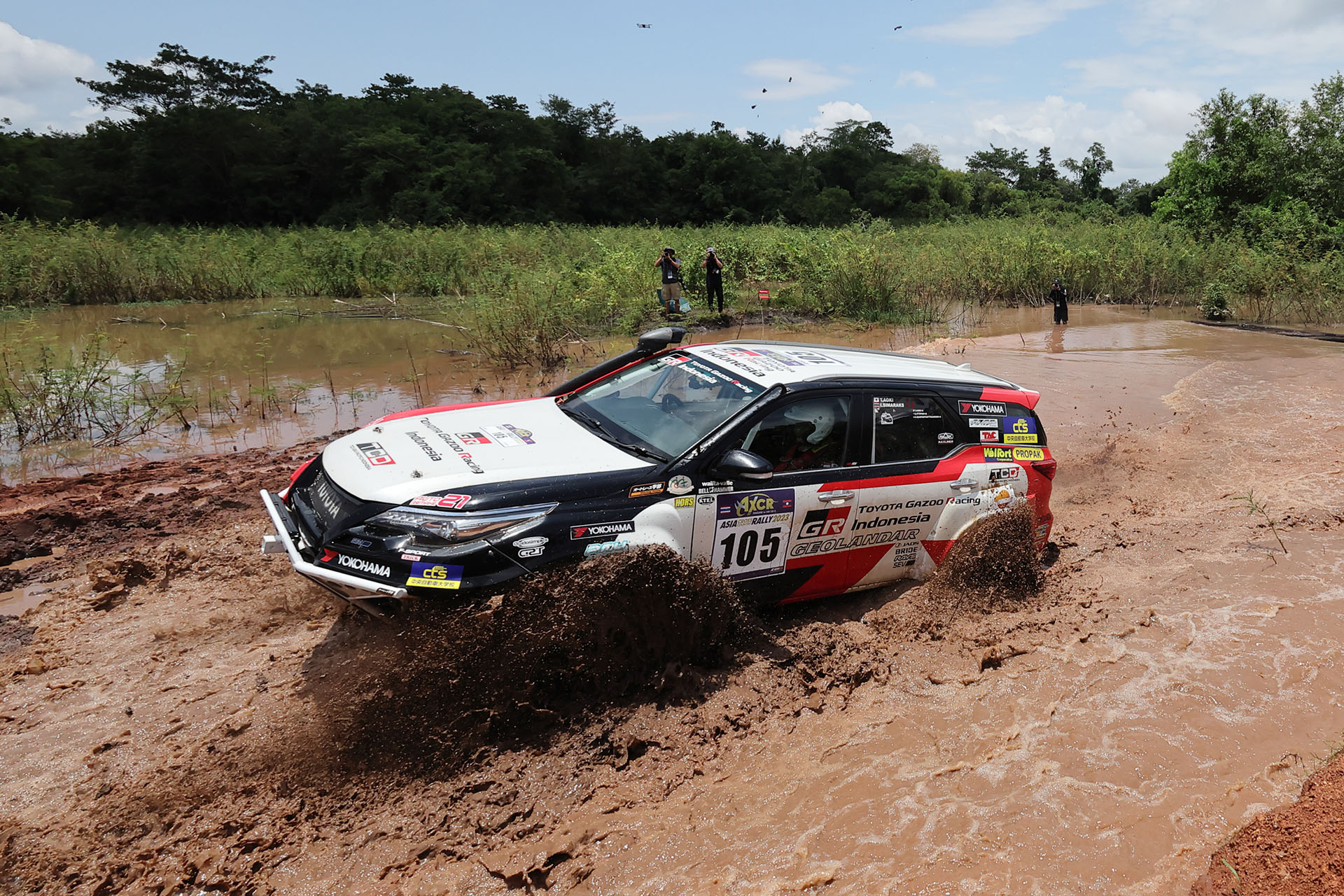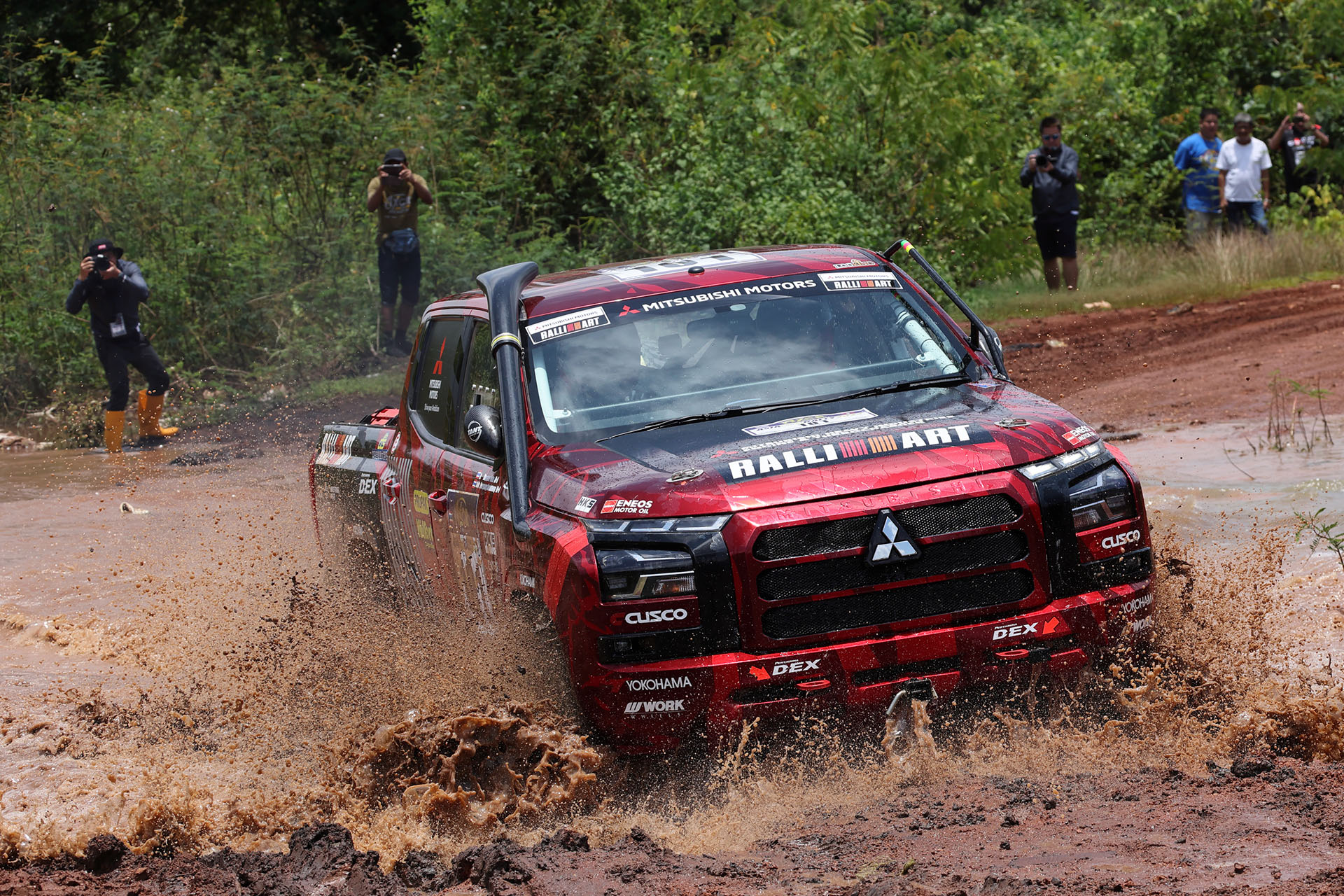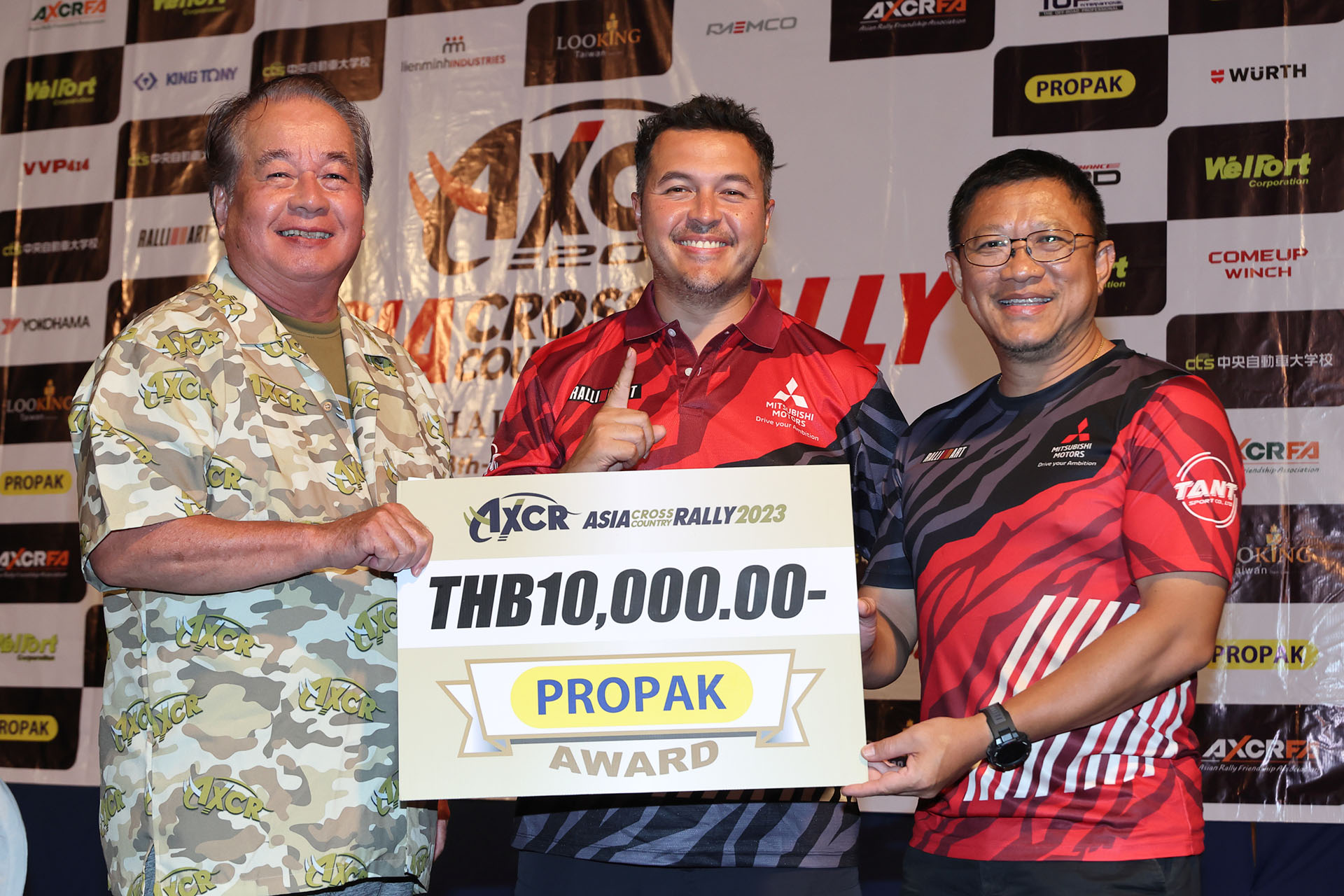









Today is the biggest highlight of the second half of the race: the SS is the longest in the Laos stage. While the first half of the course is "super" high speed, the second half features dangerous river crossings where "motorcycles and small cars can be swept away" and "tear-jerking" mud areas. "Tearful muddy areas await. The special stage was prepared to be "the Laos of Laos.
However, a check on the previous day revealed that the river crossing at the 134.29 km point in the second half of the SS had risen to a level "too dangerous for all competitors" due to rising water levels caused by rainfall. Unfortunately, the second half of the SS had to be cancelled. As a result, SS5 was shortened from 167.82 km to 120.76 km.
However, the route was by no means easy. A river crossing was also provided just after the start at a point 120m from the start. This point was easily approachable, and many villagers and rally officials gathered to watch the event from a large crowd of spectators.
Here, MOTO were able to cross a narrow wooden bridge while maintaining their balance, but four-wheeled vehicles had to navigate through a deep river. Some of the riders were able to continue through the river, but their feet were caught in the unevenness of the deep river bed which hid even their mufflers, and the water sucked from their air cleaners caused their engines to stop stranding them. The bike was eventually pulled out of the river with the help of spectators, but the engine could not be started by turning the cell and it was necessary to remove the water from the cylinders. When the bike restarted, there was a round of applause.
Most interesting was the sidecar of the #66 Rising Sun Racing with JRSA team of Masato Watanabe (Japan) and Masahiro Ozeki (Japan). Due to the structure of the machine, they had no choice but to cross the river, but the mud on the river bottom prevented them from going forward, but the body remained stable without collapsing. The two passengers immediately got off to prevent the engine from stalling, opened the throttle and pushed the car by hand with traction provided by the two wheels behind them to escape safely. Although MOTO are faster on most terrain, factors such as the stability of the vehicle body, the stronger traction provided by two wheels plus the manpower of one passenger make the vehicle more reliable on such rough terrain.
The AUTO differed from driver to driver in the way they were driven. Drivers who jumped into the car with great force tended to lose a lot of thrust in the early stages due to water pressure and in some cases, damage the front bumper and other plastic parts and from the middle stage onward to regain the lost momentum, they tended to open the engine to full throttle, spin the tires, and get out while roughing up the road surface.
In contrast, the cars that drove a little slower in the early stages of the race and accelerated slowly from the middle to the end of the race had less splashing, no spinning tires, and ran through the race smoothly. It seems that the style of running that cut through and pushed through the water, rather than fighting against it, provided better traction.
Among them, the way the yellow machine of Raz Yehoshua (Israel)/Heymann Hillel Segal (Israel) of the #130 Pointer Team from Israel ran was very smooth and beautiful.
They are a private team formed in 2005 and their vehicle is a self-made machine with an all-tubular frame using a Mitsubishi Pajero drivetrain. They have competed in nearly 40 cross-country rallies to date including the Pharaoh Rally, the Dakar Rally, and the Silk Way Rally. He has competed in nearly 40 cross-country rallies to date, including the Pharaoh Rally and the Dakar Rally, as well as the Silk Way Rally.
When I asked them why they replied, "We were able to get the car back to the hotel room in time to finish the work before the rest of the teams did. When asked why the answer is simple: "We come in with six days' worth of work done in advance. But "The important thing is to work on the machine and run without breaking it. And since there are only two of us, we can't take parts apart every day. So we have a policy of replacing only the parts that break.
He concluded by saying, "In a cross-country rally, the finish is more important than anything else. If you don't break anything, the results will come. It has been and always will be just the three of us: the driver, the navigator (car builder), and our car. Rallying is fun! Please support us!
Recently, the focus of the Asian Cross Country Rally has been on the works teams, but if you go back 10 or 15 years in the history of the rally, you will find many small private teams like this one participating in the rally. The primary finish was to survive and reach the finish every day in a survival competition using a tough machine like the Land Cruiser. They were the first to arrive at the finish line.
Cross country rallies are also a battle of privateers. The two members of the Pointer Team are very friendly people and I hope everyone will take this opportunity to become friends with them.
The top time of the day was set by Yasubumi Sunakawa (JPN) of #15 Team OTOKONAKI. In second place was Koun Phandara (KHM) of #2 Team Cambodia, who finished 3 minutes 38 seconds behind, followed by Hironori Nishimura of #1 Team Japan.
Jakkrit Chawtale of #17 JC DIRT SHOP Rally Team (THA) came in first overall and perhaps because Jakkrit had gained more than enough of an advantage in the first half of the rally, he was able to finish the day with a pace about 10 minutes slower than the leader. He is now fully prepared for the final day.
In second place overall is Team Japan's Hironori Nishimura (Japan) who is more than one hour ahead of Jakkrit, but also more than 20 minutes ahead of Team Cambodia's #2 Koun Phandara (Cambodia) who is in third place. The following 4th place is Team Cambodia's #16 Chhour Chan Sovan (Cambodia) who is 14 minutes behind 3rd place and Team OTOKONAKI's Yasushi Sunagawa (Japan), who is in 5th place, with a 46 minute gap between them who is in sixth place overall, the top group is not expected to move much unless there is a major mistake or breakdown on tomorrow's final day.
In the AUTO category, Rifat Helmy Sungkar (IDN) / Chupong Chaiwan (THA), #106 of Team MITSUBISHI RALLIART, drove a blistering race to the finish line in an amazing 1 hour and 5 minutes as if to clear away the frustrations of yesterday. Rifat's new Triton had the damaged rear side panel removed leaving the rear side frame and spare tire completely exposed which matched his spirited performance and made for a very memorable run. The always cheerful Rifat was in good form and the entire MITSUBISHI RALLIART team was full of energy.
The second fastest time was set by NEXZTER REST CLUB (NXRC) #108 Theerapong Pimpawat (THA) / Jumpol DOUNGTHIP (THA) in their HILUX LEVO. They are showing their persistent efforts to catch up in the second half of the race.
The third fastest time was set by TOYOTA GAZOO RACING INDONESIA's #105, Takuma Aoki (JPN) / Ittipon Simaraks (THA) Songwut Danphiphattrankoon (THA) were the Toyota Fortuner team.
Takuma Aoki had a strong presence in the race this day setting good times to finish in the top 3 while driving steady with priority on not breaking the machine, but in fact, there was a situation that made the whole team pale. After checking, we found that only one hub bolt was left. The navigator, Ittipon, and Songwut, who was riding with him as the second co-driver carried out emergency repairs. They managed to get the car back on the track and headed for the hotel at the finish, but when they arrived at the hotel, the clock was showing that they would have to pay a time penalty if they were two minutes late. If a time penalty had been added, the overall standings would have changed drastically.
The teammates of Tubagus Moerinsyahdi (IDN) and Jatuporn Burakitpachai (THA) of #121 TOYOTA followed in 4th place.
In fifth place was the #102 TOYOTA GAZOO RACING THAILAND team of Jaras Jaengkamolkulchai (THA) and Sinopong Trairat (THA). last year's 2nd place finishers, are determined to move up as much as possible. In 6th place, the Team MITSUBISHI RALLIART of #101 Chayapon Yotha (THA) and Peerapong Sombutwong (THA), who won last year continued to fight for their hopes until the very last moment.
The overall leader remains the same as yesterday, with the TOYOTA GAZOO RACING INDONESIA #105 team of Takuma Aoki (JPN) and Ittipon Simaraks (THA) and Songwut Danphiphattrankoon (THA). They were followed by teammates Tubagus Moerinsyahdi (IDN) and Jatuporn Burakitpachai (THA) in the #121 TOYOTA.
Closing in on these two cars are last year's champions, the #101 Team MITSUBISHI RALLIART pair of Chayapon Yotha (THA) and Peerapong Sombutwong (THA). The gap to the leader, Aoki, is approximately 17 minutes.
The yellow car of Raz Yehoshua Heymann (ISR) and Hillel Segal (ISR) of the #130 Pointer Team was the first to break into the works and semi-works battle between Toyota, Mitsubishi, and Isuzu. The yellow car of Raz Yehoshua Heymann (ISR) and Hillel Segal (ISR) of the #130 Pointer Team is almost an hour behind the 3rd place finisher, Chayapon, but depending on the results of tomorrow's final SS, they have a good chance of finishing in the top 3 overall.
Now whether we cry or laugh, there is only one more day of competition, and only one more SS to go!
As announced at the briefing the night before, the roads in Lao P.D.R. contained a lot of water and were difficult to drive on. The organizers also deemed the river crossing scheduled for the second half of the SS to be dangerous and cancelled the entire second half of SS5, thus ending the competition on Day 5 (LEG5) at the PC stop at the halfway point.
With the distance to be covered halved and the river crossing, the main dish of the event, eliminated, competitors in both the MOTO and AUTO classes thought they might be suffering from indigestion, but when the race was over, there were a few comments from the AUTO class participants, "I am so full. ......
This morning, the MOTO photography team headed to the starting point of SS5 with plenty of time to spare, and entered the SS route on foot to look for a photo point. Walking in heaps on the damp red soil, the soles of our trekking boots were heavy on our feet due to the heavy red soil clinging to the soles. This is a pattern that can catch you off guard.
Speaking of which, it rained a lot last night. Four tents (about 3 x 3 meters) were erected in the paddock for the Japanese competitors, but one of them was rendered useless by the weight of the water, which bent the frame.
The surface of the SS was clearly different from the feeling of the soles of shoes until yesterday, such as gatsu gatsu (dry hard red soil), jari jari (gravel), shakuri shakuri (grass), and mosuri mosuri (sand)......, and was "watery," "wet," and "wet. ...... and feel "watery". However, it is not the extremely muddy road reported in the preliminary survey. It looks like damp red soil, with large puddles in some places.
While I was walking with my camera bag on my back and camera around my neck, local people were riding on scooters or business motorcycles on the wet red dirt road, toto-toto-toto ....... It's impossible not to slip on such a bike (tires), but they go slowly and surely without seeming to fall. And it is usually a two-seater or more, for example, the wife in the back sits sideways on the rear carrier or seat, both of them have sandals on their feet, the husband has farm equipment, etc. in one hand, and if the wife is sitting astride in the back, he sandwiches a small child between them and heads for his field ....... This is exactly the kind of scene one often sees at AXCR.
As I was thinking about this, I was approached by a man in military uniform on a scooter who took pity on me when he saw my back figure walking silently along the long stretch of road that I could see far ahead and offered me a ride in the back seat. Sure enough, the tires of the motorcycle were sliding both in front and behind. There was no sign of falling, but the person stepping on the tandem step with camera in hand was not in the least bit concerned. Moreover, the sole slid off the step due to the red soil and came off several times.
With the help of the kindness of the locals, we decided on a spot to take pictures on the unchanging, meandering road and waited for the riders to arrive again as usual. Such was the beginning of the day.
The first challenge for the riders came just 120 meters from the start. The river flow was slow, and a few meters above the surface of the water was a handmade bridge made of three logs and a 60-cm wide panel of wood on top.
In this scene, the MOTO crosses the bridge, and the AUTO crosses the river. I wondered, "What about the sidecar with three tires? The bridge is too narrow to pass through. If the boat were to float on one wheel, it might be possible to cross, but it would be a risky choice. As for the river, it depends on the depth and the condition of the river bottom.
When we asked a couple of sidecar drivers who completed the route that day, they said that the passenger entered the river, checked the depth and the bottom, and entered the river when he judged that he could go. They said that this happened several more times.
According to the riders who finished in the top group, although the distance was short, about a quarter of the course was slippery, and if the riders failed to assess this and rode at a fast pace on the slippery surface, they would easily fly off the road.
Also, following the Thai and Cambodian riders who were leading the race, they said that their pace was moderate compared to yesterday, but they were able to go faster where they could.
They were accustomed to running with a high level of caution against slips, holes, and gaps, and it seemed that this gave them a big advantage.
On the second day in Lao P.D.R., which was "watery" with some rain falling along the way, a Taiwanese rider on a Yamaha Ténéré 700 crashed on the SS and was apparently unable to move for a while. Another rider fell hard on the asphalt road past the SS finish, sustaining damage that included broken bones.